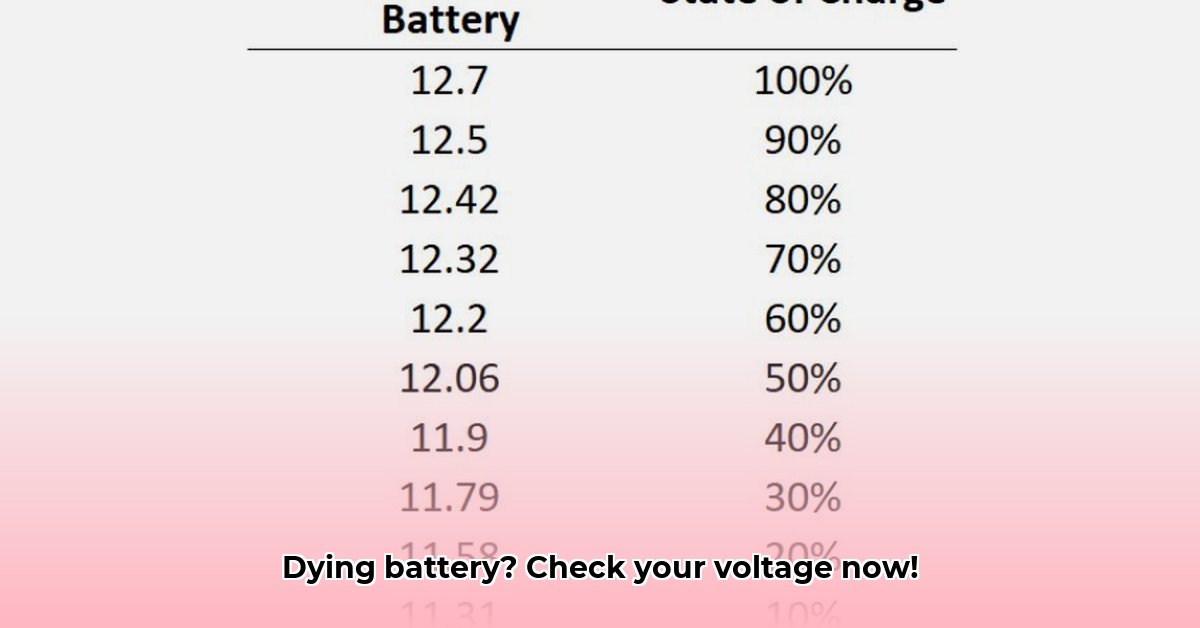Ever been stranded because of a dead car battery? It’s frustrating, but preventable. Knowing your car battery’s average voltage is key. This guide covers everything about car battery voltage – how to check it, what the numbers mean, how to maintain your battery’s health, and the impact of external factors like temperature. For more on energy units, see this helpful conversion guide: Ah to kWh. By understanding these simple steps, you can avoid breakdowns and save money.
Average Car Battery Voltage: The Key to Avoiding Roadside Trouble
A dead battery is a common cause of car trouble. Understanding your car’s battery voltage is the first step in avoiding this problem, enabling preventative maintenance. It’s simpler than you think and can save you time and money. Discover the importance of car battery maintenance through regular checks and a proactive approach.
What’s a “Normal” Battery Voltage? Aim for the Sweet Spot
A healthy car battery, when the engine is off (resting state), should read between 12.4 and 12.8 volts. This range is ideal. If your battery falls outside this, be aware of the voltage drop and be careful. Note that temperature can affect these readings (more on that later).
* Optimal Range: 12.4V – 12.8V (Engine Off)
* Low Voltage Indication: Below 12.4V (Engine Off)
* High Voltage Indication (with engine running): 13.7V- 14.7V
When the Engine’s Running: Teamwork Makes the Dream Work
When you start the engine, the car’s alternator takes over. It should boost the voltage to between 13.7 and 14.7 volts, maintaining the ideal car battery voltage. This extra power keeps your battery charged and runs the car’s electrical systems. A low voltage while the engine runs could indicate alternator problems, a loose belt, or issues with the voltage regulator.
Checking Your Battery Voltage: Surprisingly Easy
You don’t need a mechanic’s expertise – just a multimeter. These are available at most auto stores for a reasonable price. Digital multimeters are often easier to read than analog versions.
Step 1: Safety First! Wear safety glasses to protect your eyes from potential battery acid splashes. If you’re disconnecting the battery, disconnect the negative (-) battery terminal first to prevent short circuits.
Step 2: Setting Up Your Multimeter: Set your multimeter to measure DC voltage. The setting will probably be labeled with a “V” with a straight line above it (VDC). Select a range of at least 20V. If you have an auto-ranging multimeter, it will select the correct range automatically.
Step 3: Making the Connections: Attach the red (+) lead to the positive (+) terminal and the black (-) lead to the negative (-) terminal. Ensure good contact. Clean any corrosion before testing for an accurate reading.
Step 4: Reading the Results: Your multimeter will display the voltage. Compare this to the chart after this to evaluate the reading. Note the reading and the date so you can track changes over time.
Deciphering Your Battery’s Message: What Do the Numbers Mean?
The voltage reading indicates the state of your battery. These interpretations are general guidelines, so consult your vehicle’s manual.
| Voltage Range (Engine OFF) | Possible Condition | Suggested Action |
|---|---|---|
| 12.6V – 12.8V | Fully Charged (Good!) | Keep an eye on it with regular checks. Nothing to worry about for now. |
| 12.4V – 12.6V | Slightly Discharged | Monitor the voltage closely. Consider a slow charge if the low voltage persists. Check for parasitic draws (see below). |
| 12.0V – 12.3V | Moderately Discharged | Charge the battery immediately. Investigate possible issues with your charging system. |
| 11.8V – 11.9V | Significantly Discharged | Charge the battery immediately. Have your charging system tested professionally. |
| Below 11.8V | Needs Immediate Attention – Possibly Replacement | Fully charge your battery, then retest. If the voltage remains low, it’s likely time for a new battery. Consider a load test. |
Beyond Voltage: Other Signs of Battery Trouble
A low voltage isn’t the only warning sign. Watch out for these:
- Sluggish Engine Cranking: The engine turns over slowly, especially in cold weather.
- Dim Headlights: Weaker headlights indicate a failing battery (test with the engine off).
- Corrosion: Corrosion appears as a white, blue, or green powdery substance on the terminals impeding electrical flow; therefore, clean it using a wire brush and a baking soda solution (1 tablespoon baking soda to 1 cup water). Apply a terminal protector after cleaning.
- Swollen Battery Case: This is a sign of overcharging or internal damage.
- Rotten Egg Smell: This can indicate a leak of sulfuric acid.
Keeping Your Battery Happy: Preventative Care
Regularly checking your battery voltage is like a checkup. This small effort can extend its life, helping to avoid a costly breakdown.
- Regular Voltage Checks: Check the voltage monthly, especially before long trips or during extreme weather.
- Keep Terminals Clean: Clean corrosion regularly.
- Secure Battery: Ensure the battery is securely mounted to prevent vibration damage.
- Minimize Short Trips: Short trips don’t allow the alternator to fully charge the battery.
- Turn Off Accessories: Turn off headlights, radio, and other accessories when the engine is off.
- Battery Tender/Maintainer: If you don’t drive the car regularly, use a battery tender to keep it charged.
Understanding Parasitic Draw
Even when your car is off, some systems draw small amounts of power (e.g., alarm system, clock). Excessive draw (parasitic draw) can drain the battery over time. To test for parasitic draw:
- Ensure all accessories are off.
- Disconnect the negative battery cable.
- Connect a multimeter (set to measure milliamps – mA) between the negative cable and the negative battery terminal.
- A normal parasitic draw is typically less than 50mA. Higher readings indicate a problem.
Final Thoughts: Don’t Be Stranded!
Understanding your average car battery voltage gives you the power to prevent car trouble. Checking it regularly helps maintain optimal car battery performance, avoid frustration, and potentially save on repair bills. Proactive maintenance and knowing the warning signs are key to a reliable vehicle.
How to Interpret Car Battery Voltage Readings Under Different Load Conditions
Key Takeaways:
- A healthy battery reads between 12.6 and 12.8 volts, engine off, indicating a fully charged car battery.
- Consistent low readings (below 12.2V) indicate a failing battery.
- High voltage (above 14.7V with the engine running) suggests overcharging.
- Understanding both engine-off and engine-on readings is essential.
- Regular voltage checks are vital for preventative maintenance.
Understanding Your Battery’s Voltage: Engine Off
Think of your car battery like a water tank. When the engine’s off, the voltage reading shows how full the tank is. A fully charged battery at room temperature usually registers between 12.6 and 12.8 volts. Anything lower requires a recharge, highlighting the need for effective car battery management. Readings consistently below 12.2 volts indicate the battery is weak and may need replacement. Consider the battery’s age; most car batteries last 3-5 years.
Under Load: The Engine’s Role
When you start the engine, the alternator (the “pump”) refills the battery. This is when assessing car battery health becomes critical. A typical range is 13.7 to 14.7 volts. Too high (above 14.7V) indicates overcharging from the alternator, which can damage the battery. Too low indicates a malfunctioning charging system. Check the alternator belt for proper tension and condition.
Testing Your Battery Voltage: A Step-by-Step Guide
- Gather tools: Digital multimeter (DMM) and safety glasses.
- Safety First: Disconnect any accessories. Handle car batteries carefully. Batteries contain sulfuric acid, which can cause burns.
- Engine Off Test: Connect the DMM’s red lead to the positive (+) terminal and the black lead to the negative (-) terminal. Note the voltage reading. Allow the car to sit for at least 30 minutes after it has been running for an accurate reading.
- Engine On Test: Start the engine and let it idle for a few minutes. Check the voltage again.
- Interpret Results: Compare your readings to the ranges discussed earlier.
Decoding the Readings: A Simple Table
| Voltage Range (Volts) | Engine State | Condition | Action |
|---|---|---|---|
| 12.6 – 12.8 | Off |
- Hydro Extrusion USA LLC Provides Extensive Custom Aluminum Extrusion - December 29, 2025
- Hydro Extrusions USA Leads North American Aluminum Profile Solutions - December 28, 2025
- Hydro North America Leads Aluminum Extrusion Solutions Across Diverse Industries - December 27, 2025
















